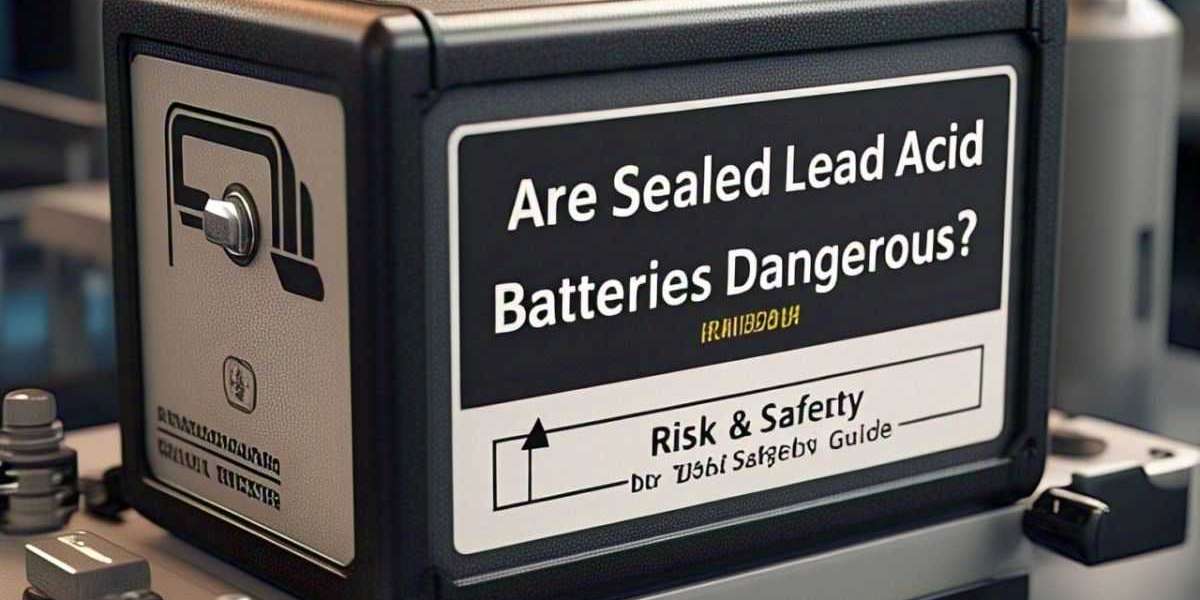Are Sealed Lead Acid Batteries Dangerous? Risks Safety Guide
Sealed lead acid (SLA) batteries are widely used in backup power systems, alarm systems, and mobility devices. While they're efficient and durable, people often ask: Are they truly safe to use? In this guide, we'll explore the risks associated with SLA batteries, how to handle them properly, and the safest ways to use and store them without danger.
What is a Sealed Lead Acid Battery?
A sealed lead acid battery is a type of rechargeable power source that uses lead dioxide and sponge lead plates immersed in sulfuric acid. Unlike traditional flooded batteries, SLA batteries are sealed, which prevents leaks and makes them maintenance-free. These are commonly found in emergency lights, alarm systems, mobility scooters, and uninterruptible power supplies (UPS).
Their sealed design reduces spillage, but that doesn't make them risk-free. Understanding the inner chemistry helps to assess the potential dangers and safety measures .
Where Are SLA Batteries Commonly Used?
Sealed lead acid batteries are extremely versatile. You'll find them in many everyday devices, including:
Home security systems
Medical equipment
Power tools
Solar energy storage
Emergency lighting
Due to their reliability, they are often used in critical systems. This makes understanding safe handling essential .
Are There Fire Risks with SLA Batteries?
Yes, there is a fire risk—but it is relatively low when batteries are used correctly. Overcharging or short-circuiting an SLA battery can cause thermal runaway, which generates excessive heat and may lead to a fire or explosion. Using a compatible charger and ensuring correct installation can greatly reduce this risk.
Can SLA Batteries Explode?
While rare, explosions are possible under certain conditions. If the battery is overcharged or exposed to extreme heat, gases may build up inside. If not vented correctly, the internal pressure can rupture the case. Always store batteries in a cool, dry environment and avoid exposing them to direct sunlight or enclosed heat.
What Are the Chemical Hazards Inside SLA Batteries?
SLA batteries contain sulfuric acid, which is highly corrosive. If the battery case cracks or leaks due to damage or manufacturing faults, the acid can cause burns or injuries. This makes it important to wear gloves and eye protection while handling batteries, especially during disposal or recycling.
Are SLA Batteries Safe Around Children and Pets?
No battery should be accessible to children or pets. SLA batteries, although sealed, can pose risks if punctured or damaged. The acid and lead content are toxic. Always keep batteries stored in high, locked cabinets if kids or pets are in the home.
How to Store SLA Batteries Safely
To reduce risks, follow these simple storage tips:
Keep in a well-ventilated space
Avoid storing near flammable materials
Don’t stack batteries on top of each other
Keep away from moisture or dampness
Proper storage not only prevents hazards but also extends battery life significantly.
Safe Charging Practices for SLA Batteries
Charging errors are one of the most common causes of battery failure or danger. Always use a charger specifically made for SLA batteries. Overcharging can lead to gas buildup, while undercharging can reduce lifespan. Some smart chargers have built-in safety systems, so investing in one is highly recommended.
You can find SLA-compatible batteries like the 12V 40Ah CJ12-40 Rechargeable Alarm Battery designed for secure and reliable performance.
Are SLA Batteries Recyclable or Harmful to the Environment?
Yes, sealed lead acid batteries are recyclable, and it’s the best way to dispose of them safely. Dumping them in the trash is dangerous because of their lead and acid content, which can contaminate soil and water. Many recycling centers and battery retailers offer battery return programs.
Always discharge a battery before disposal and place it in a leak-proof container if transporting to a recycling facility.
How to Handle a Leaking SLA Battery
If you ever come across a leaking SLA battery, take immediate precautions:
Wear protective gloves.
Avoid touching the liquid directly
Don't wash it down the drain.
Seal the battery in a plastic container
Take it to a proper hazardous waste center
If you need a full breakdown of safety issues and prevention, explore this in-depth safety resource that covers all scenarios and protective actions.
What Happens If You Drop an SLA Battery?
Dropping a sealed lead acid battery might cause cracks or internal damage , which may not be visible immediately. This could lead to slow leaks or internal short circuits. If a battery is dropped, observe it for any swelling, leaking, or strange smells. When in doubt, replace it immediately .
Are SLA Batteries Suitable for Outdoor Use?
SLA batteries can be used outdoors, but only in weatherproof enclosures . Excessive heat, rain, and direct sunlight can all reduce the battery's efficiency and safety. Use protective casing and install batteries in shaded, moisture-free environments for best results.
You can browse secure SLA battery setups available from specialized security battery providers to ensure safety and performance in outdoor applications.
Tips for Extending the Life of Your SLA Battery
Taking care of your battery not only improves safety but also saves you money . Follow these best practices:
Charge at the right voltage
Avoid deep discharges
Do not mix new and old batteries
Use batteries regularly if possible
Clean terminals to prevent corrosion
These simple tips can make a big difference in long-term reliability and risk reduction.
FAQs - Sealed Lead Acid Battery Safety
1. Can I charge a sealed lead acid battery overnight?
Yes, if you're using a smart charger that automatically stops when full.
2. What should I do if my SLA battery swells?
Stop using it immediately and dispose of it at a battery recycling facility .
3. Is it dangerous to use an old SLA battery?
Yes. Aging batteries can develop internal faults, which may lead to leakage or fire .
4. Can SLA batteries be stored in a garage?
Only if the garage is temperature-controlled and dry .
5. Are SLA batteries allowed on airplanes?
Most airlines have restrictions. Check airline policy before attempting to carry SLA batteries .
6. What's the lifespan of a sealed lead acid battery?
Typically 3–5 years , depending on use and maintenance.
Conclusion: Are Sealed Lead Acid Batteries Truly Dangerous?
SLA batteries can be dangerous , but only when misused. With proper charging, storage, and disposal, they are one of the safest rechargeable battery types available. Whether you're using them in a home alarm system or as a power backup, following this safety guide can help prevent accidents and extend battery performance.
Remember: Always stay informed and purchase batteries from reliable sources. Stay safe, stay powered!








